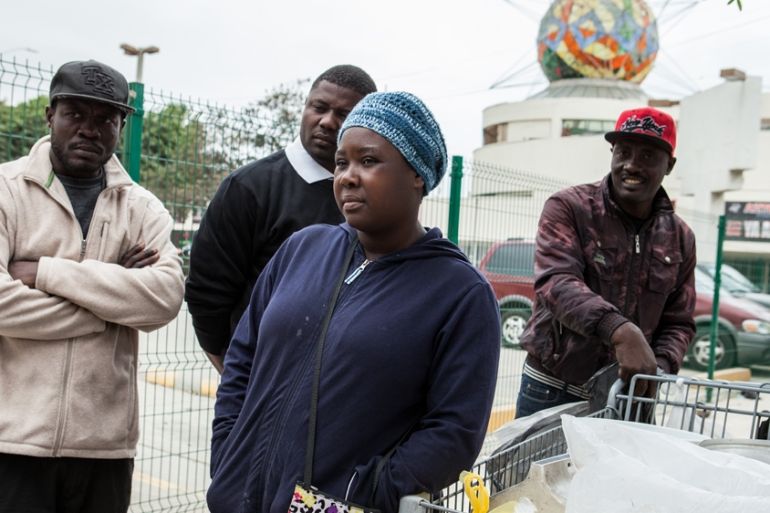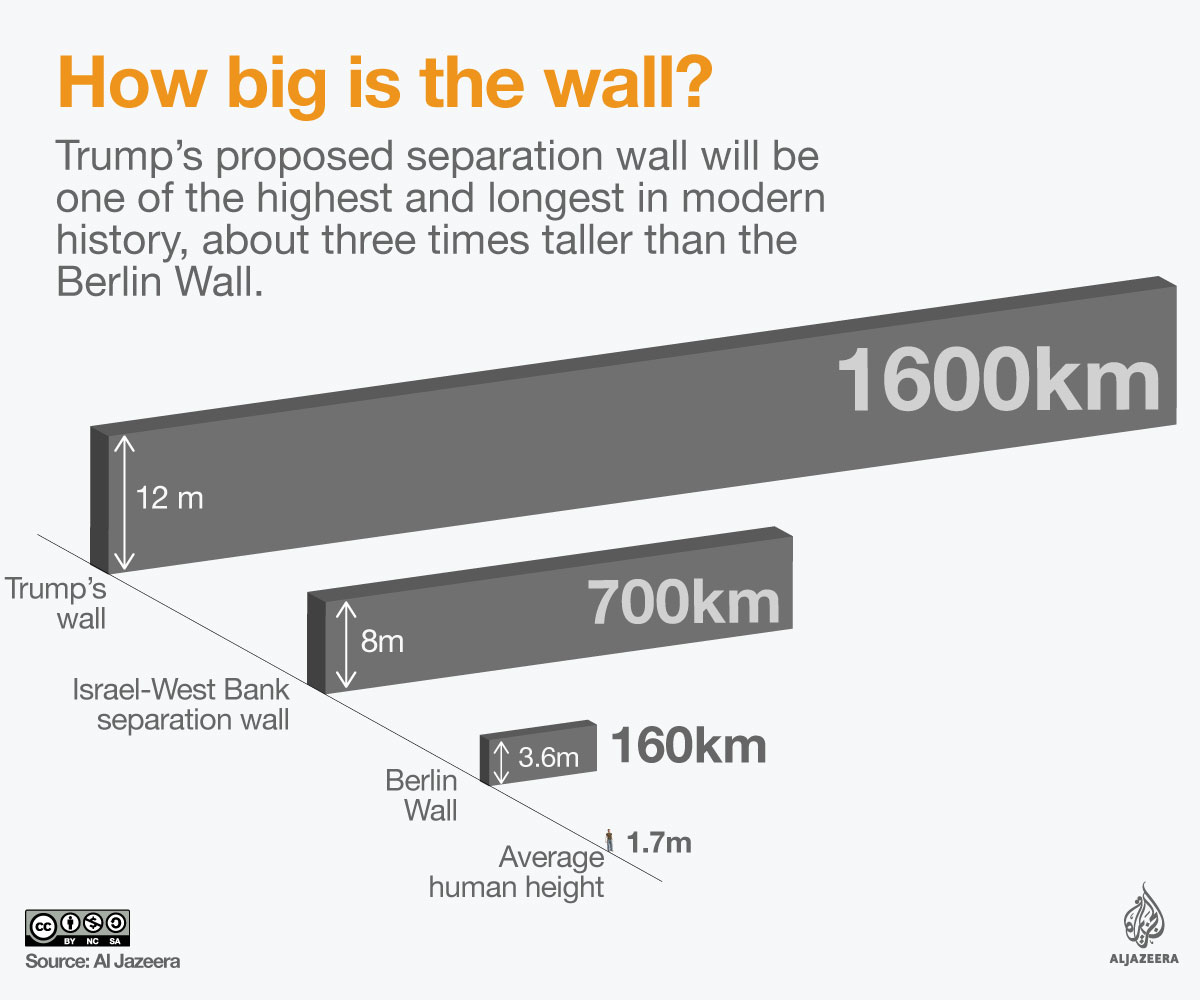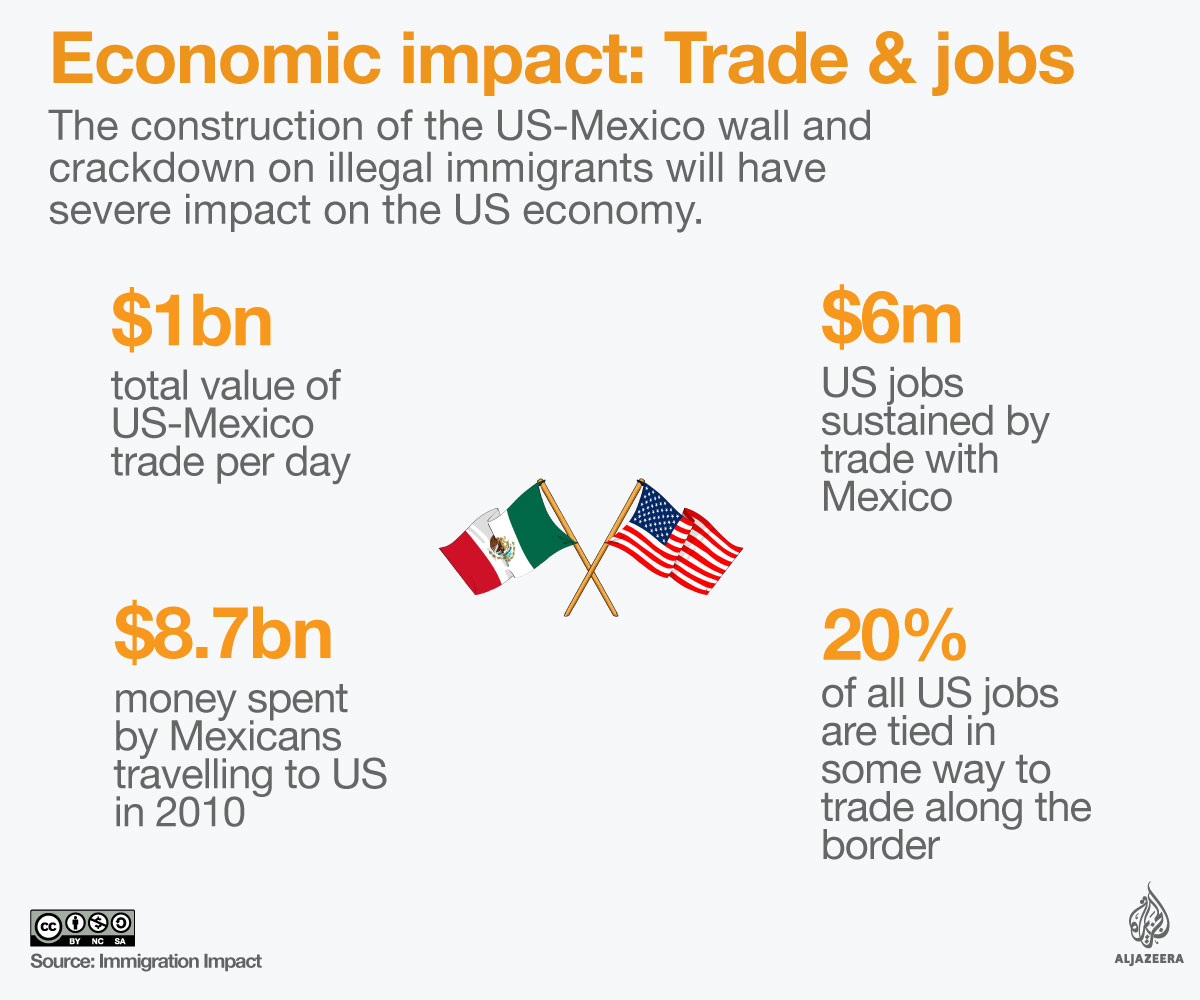The cost of Trump’s wall for migrants
Haitian migrants trying to reach the US say Mexico has offered them what the US will not: refuge.

Tijuana, Mexico – Mexico has stepped in to offer Haitian migrants – escapees from natural disaster – what the United States and other more wealthy countries will not: Refuge.
Outside a string of businesses in the city centre, a young man walks with purpose to his new job. He is from Haiti , like many who came during the Trump campaign and after Hurricane Matthew , which claimed well over 1,000 lives in the country late last year.

“Mexico offered us [Haitian refugees] to stay here, even though the US is much more rich, culturally and economically – but they don’t want to. We suffered chaos in our country after the devastating earthquake [in 2010]. Mexico allowed us in to work to help our families. The US just wants to deport us,” said the man, who asked to be called Wesley so that his interview would not affect his residency status.
Keep reading
list of 4 itemsWhat happens when activists are branded ‘terrorists’ in the Philippines?
Are settler politics running unchecked in Israel?
Post-1948 order ‘at risk of decimation’ amid war in Gaza, Ukraine: Amnesty
In Tijuana, Wesley has a job and a shared apartment. “Mexicans accept us as humans – even with our differences,” he said. “The US should learn from Mexico how to have a heart.”
He started his journey like many Haitians – in Brazil , smuggling himself through an “impossible route”. In some cases Haitians travel through nine or 10 countries. Wesley spent about $5,000 on his journey. “It’s a lot of money. But we want a better life,” he said.
In the jungles of Colombia , many refugees such as Wesley have “seen dead Haitians – men and women – who had tried to cross. It causes great pain to see those who died.”
Wesley spoke to Al Jazeera in French. For many Haitians, French is the only language, other than their native Haitian Creole, that they speak. So coming to Mexico or the US means not only an arduous journey but a language barrier. Wesley is now learning Spanish.
READ MORE: How Trump’s immigration policies could cost the economy
There are about 3,000 to 3,500 Haitians in Tijuana alone – and another 1,000 to 1,500 in Mexicali, another border town 200 kilometres east, estimates Hugo Castro, the director of Border Angels, an organisation that delivers resources to migrants attempting to reach, or who have been deported from, the US. Some came after the hurricane in September and October 2016, but most came, he says, in April and May during Trump’s election campaign.
“It’s no coincidence it happened as Trump’s chances increased,” Castro said. “It’s the Trump effect.”
![A Haitian migrant at Zona Centro says he had hoped to make it to the US border but has found work in Tijuana instead [Jessica Chou/Al Jazeera]](/wp-content/uploads/2017/02/cc3bc91783444289965edc7070ebe458_18.jpeg)
‘ People gave up everything with their lives’
Cecilef, 32, is planning on making the trek to the US, although she is earning a decent living in Mexico – for $2 a plate, she sells traditional Haitian food to migrants on the street outside a shelter in the Northern Zone with a strict zero-drugs and alcohol policy.
The food cart has become popular with non-Haitians as well, she says. A cluster of people rejected from the shelter are camped out across the street. “They do feel better [when they eat Haitian food],” she told Al Jazeera in Creole.
Across town, in the middle of Canon del Alacran, or Scorpion Canyon, there is a large church that is home to more than 400 people from Haiti, about 60 of whom are children.

The church – the Temple of Jesus’ Ambassadors – is not accessible by car. One must walk across wooden planks over a ravine and then up a dirt path that becomes dangerous to traverse in the rainy season, locals say.
The men sleep in the large main hall at the front of the building, the women and children sleep at the back towards the kitchen, where there are large vats of water. The city only recently gave this area running water, after Castro’s Border Angels and others expressed outrage at the treatment of the new arrivals.
And still, resources here are scarce. The vats in the kitchen space are marked in Creole, Dio pou lave (washing water) and Dio pou bwe (drinking water).
It costs $200 a day to feed everyone here, Castro estimates – a small sum considering the number of people it sustains, but an extraordinary amount of money for Tijuana philanthropists.
One of the young men staying in the church, who asked to be called James, hopes to cross over to the US, but he has been cautioned against it by friends who were deported back to Haiti.
“I have friends who have been deported. They were sent back,” he said – the friends contacted people in the shelter with mobile phones via WhatsApp.
“These friends got deported on the trip [to the US], and they become like crazy people. They lose their memory,” James said.
“We are creating a lost generation among Haitians. People gave up everything with their lives and their little resources,” said another man who asked to be called George and was sitting with James in the church-shelter’s kitchen area.
When they are deported, “they have to start from zero. Everything is finished,” James said.
“Imagine that you take that kind of long road, and you spent everything to go to the US, and once you get there, you are expelled. Maybe you had a family and people counting on you. And you have nothing to show for it. You can imagine what happens to you in that situation,” James added. He “can’t count” how many people back in Haiti are depending on his successful arrival in the US, he said.
James will cross – obtain the money necessary to do so from relatives – and make the dangerous journey with the coyotes , if he must, he explained.
![A number of migrant shelters can be found in Zona Norte, known as the red light district of Tijuana and a hotbed for criminal and gang activity [Jessica Chou/Al Jazeera]](/wp-content/uploads/2017/02/4982dc79c26f4cf6a4c8fa754b594179_18.jpeg)
‘The wall will bring more death’
Coyotes have become increasingly unscrupulous in recent years.
“Now, there are no more ethical coyotes,” a person with intimate knowledge of the border-crossing industry told Al Jazeera on condition of anonymity, to avoid the kind of violence for which the smugglers are now known.
| Glossary |
|
Coyotes: The smugglers that help undocumented immigrants cross the border between Mexico and the US. US Customs and Border Patrol: The largest federal law enforcement agency of the US department of homeland security. It is charged with regulating and facilitating international trade, collecting import duties and enforcing US immigration and customs law. Vigilantes: Individuals who take the law into their own hands and act violently without lawful procedures against those whom they feel have disobeyed the laws of society. Migrants: Individuals who move around from place to place for seasonal work. Donald Trump, however, is focusing more on undocumented migrants – those migrants entering the US without the correct legal documentation. Shelters: Shelters provide accommodation for those in need. While there were existing shelters on both sides of the border, these have recently become over-crowded after the signing of the Executive Policy on Immigration. |
Once seen as vigilantes circumventing what are regarded as racist and class-based immigration policies, nowadays, many coyotes who turn back still demand to be paid as much as $10,000 – a number that has steadily increased since the 1980s, when it would cost only $300. Sometimes they hold the migrants captive until they are paid.
Still, the person said, the coyotes represent to many a singular chance – particularly amid calls to bolster the barriers – of a better life. For many migrants, they are revered in the same way that many Mexicans revere the murderous and philanthropic drug lord El Chapo.
“The line between what is good and bad is so tiny; it depends on your perspective,” the source said.
With the panic over Trump’s tightening of controls, the person said coyotes are still “going to find a way.” The only difference is that more people will be willing to risk great dangers to end up in the US. “More people are going to die,” they said.
US and Mexican authorities have in recent months found several cross-border drug tunnels. Mexican-American comedian George Lopez has joked that Trump’s wall will do nothing, because: “We got tunnels!” But those tunnels don’t transport humans, the source said, only drugs.
“How many pounds does a person weigh? 150 pounds? It’s more profitable to bring in 150 pounds of cocaine.”
The source said that the wall will act as a boon to narcotics traffickers who have been competing with their counterparts in the US.
“The wall will bring more death. Is it going to be safer? It depends on your perspective.” The wall may keep some migrants out, but only time will tell how many more will die taking desperate measures to find workarounds.
The trek across the border is especially difficult for some of the most vulnerable migrants.
PART 1: How Trump’s wall is affecting those at the borders
Their prospects are often no better if they attempt to enter the US without the help of smugglers.
George said that he and his pregnant wife went to the US border – as opposed to sneaking into the country – months before Trump’s election. Border Patrol let her in but turned George away. George does not speak English and was unaware of what was happening.
“There is no way to express what it feels like to see your wife on the other side,” he said.
He has relatives in the US and his wife will soon give birth. “I won’t see my baby when it’s born,” he said. Under the administration of former US President Barack Obama, pregnant women were sometimes accepted into the US, but now they, too, are being deported, George said.
George’s eyes water, but he does not cry. The Haitian revolution that began in 1791 was a slave rebellion that not only granted the country independence from France but made it the first majority-black republic in the world. For him, Haiti’s is a history of resilience that inspires.
“We have to fight,” James said.
“That’s our culture,” George agreed.
![The double US-Mexico wall as seen from Playas de Tijuana in Mexico [Jessica Chou/Al Jazeera]](/wp-content/uploads/2017/02/d777044f180545d88baee4c139ebe454_18.jpeg)
This is the second story in a five-part series looking at the US-Mexico wall and the people who live alongside it. If you want to follow this story, please enter your email here